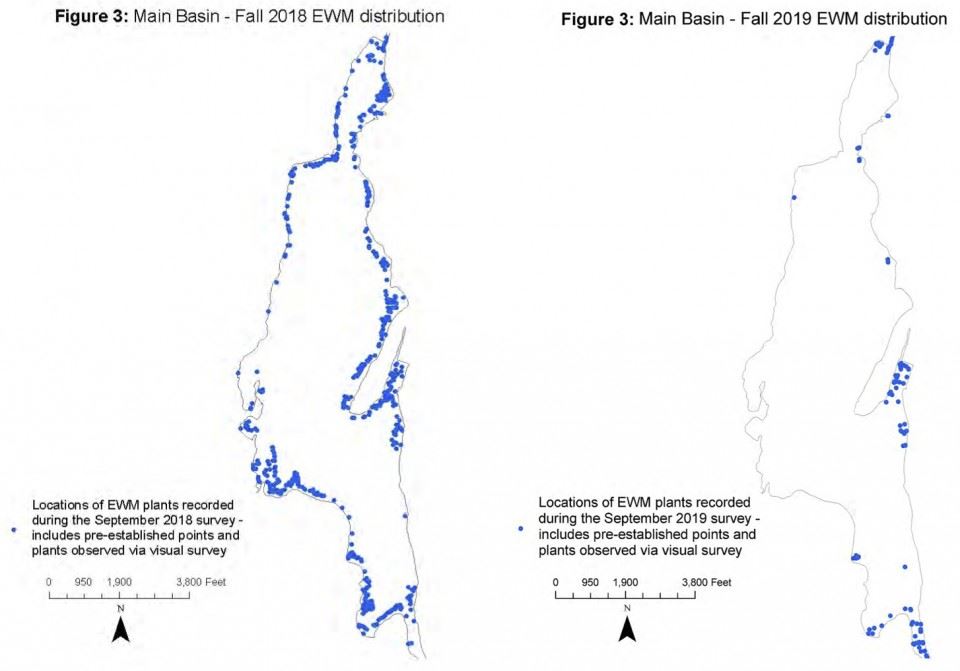On Tuesday, January 6th, the Lake St. Catherine Association was happy to have the opportunity to update Misha Cetner from the Vermont DEC on our successful lake management efforts in 2019.
Presenting with our contracting partner, Marc Bellaud from SOLitude Lake Management, we first discussed our milfoil control program.
Using our balanced approach of spot herbicide treatments (using the new herbicide ProcellaCOR) and our hard-working DASH team (removing 1,293 buckets of milfoil), milfoil was successfully controlled in treatment areas. From our 2019 Aquatic Vegetation Management Report:
“Eurasian watermilfoil (EWM) distribution decreased significantly from 62% to 15% over last year’s frequency of occurrence and percent EWM cover decreased to 2%, at survey points within the Main Basin.
EWM control was excellent throughout treatment areas, with only other areas in the basin having any observed growth, most of which were at lower densities. This year’s spot-treatments and diver assisted suction harvesting (DASH) efforts were exceptionally effective but can only provide control to those areas while some EWM growth remains elsewhere in the basin.”
After reviewing the results of this first season of use, we are encouraged by ProcellaCOR’s effectiveness, and we hope this will allow us to continue to emphasize and expand our DASH milfoil control efforts while reducing our herbicide use.
This comparison of the fall milfoil surveys from 2018 to 2019 demonstrates how effective our milfoil control program was in 2019:

We also had the chance to discuss our other lake programs which include initiatives to decrease stormwater runoff bringing phosphorus and pollution into the lake and our invasive species prevention efforts (the Greeter Program at the boat launch).
It is extremely important to limit phosphorus from entering the lake. From the USGS.gov website:
“Phosphorus is a common constituent of agricultural fertilizers, manure, and organic wastes in sewage and industrial effluent. It is an essential element for plant life, but when there is too much of it in water, it can speed up eutrophication (a reduction in dissolved oxygen in water bodies caused by an increase of mineral and organic nutrients) of rivers and lakes. Soil erosion is a major contributor of phosphorus to streams. Bank erosion occurring during floods can transport a lot of phosphorous from the river banks and adjacent land into a stream, lake, or other water body.”
Limiting phosphorus reduces nutrients for weeds and reduces the chances of having a cyanobacteria bloom.
We are happy to be supporting the Poultney Mettowee Natural Resources Conservation District’s (PMNRCD) Lake St. Catherine Stormwater Masterplan as they begin implementing stormwater mitigation projects around the lake.
Each year, we also promote their Lake Education and Action Program (LEAP) program. The LEAP program works with lakeshore property owners to provide native buffer plantings, and apply other stormwater mitigation techniques like infiltration steps.
We also discussed our partnership with the PMNRCD in promoting the Lake Wise Program. From the Lake Wise website:
"The goal of Lake Wise is to establish a new normal, a new culture of lakeshore landscaping that is proven to help protect the lake. A property that earns the Lake Wise Award will represent a 'model' shoreland property. The Lake Wise Award certifies a property is well managed, using shoreland Best Management Practices, and is maintained to care for the lake."
This lead to the first Lake Wise Award being presented to a LSC property owner, The Binghams (you can read about that here).
If you are interested in having your property assessed for the Lake Wise program, please email us at info@lakestcatherine.org.
Our Greeter program is very important to the health of LSC. Greeters do not just check boats and trailers for milfoil - they are checking for many invasive species that are just a lake or two away from us. These invasives include zebra mussels, spiny waterflea, asian clams, water chestnuts and starry stonewort. For example, spiny waterflea were just found in Lake Champlain and zebra mussels were recently discovered in Lake Dunmore. Our Greeters are hard working young adults who have been trained to identify these invasive species to stop them from entering LSC. They also educate boaters about the importance of looking for these invasives on their boat or trailer so they are not spread to LSC or another lake.
This season, we were happy to be selected for a grant from the Vermont DEC’s Watershed Grant Program for $4,942. This allowed us to expand our daily Greeter hours, add coverage for fishing tournaments and to further expand hours around holidays. This resulted in inspecting 1,779 boats, a 21% increase from 2018.
We were also able to report that we’ve received 2 grants from the Lake Champlain Basin Program to expand both our Greeter Program and our Lake Wise efforts in 2020.
As you can see, we had lots of excellent news to share with the DEC!
We’d like to thank Misha and Marc for their time.
While we had a great 2019, we will continue to work to build on these successes in our ongoing pursuit of our mission of the preservation, protection and maintenance of Lake St. Catherine.
We hope to earn your support in 2020. Thank you.